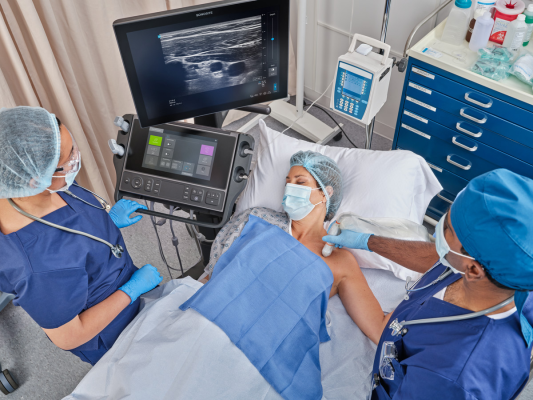
September 27, 2022 — Fujifilm Sonosite, Inc. – the world leader in point-of-care ultrasound (POCUS) solutions – has added to its next-generation POCUS portfolio with the launch of its new, premium Sonosite LX system in *Europe, featuring the company’s largest clinical image and a monitor that extends, rotates and tilts to enable enhanced, real-time provider collaboration. The clinical display features touchscreen controls to enable an optimized heads-up workflow, allowing clinicians to keep their eyes on the image while making adjustments.
The company has also launched a new T8-3 transoesophageal transducer and Cardiac Resuscitation exam type to assist clinicians in using transoesophageal ultrasound (TOU) at the point of care, both of which are designed to be used with the Sonosite LX and Sonosite PX.
“Sonosite LX was inspired by and designed with clinician partners, focusing on the evolving ways ultrasound can support the quadruple aim at the point of care, wherever that may be,” said Rich Fabian, president and CEO, Fujifilm Sonosite, Inc. “We’re thrilled to bring the Sonosite LX to Europe, building on the momentum of successful introductions in the U.S., Canada, Australia, and New Zealand. This launch reflects an ongoing commitment to delivering leading edge technology for clinicians and their patients, technology that’s backed up by a world-class ecosystem of services, support and education.”
Sonosite LX Point of Care Ultrasound System
Sonosite LX has a large, adaptable 21.3” clinical display that extends, rotates and tilts to accommodate the varied clinical environments at the bedside. The system’s small footprint and adjustable display foster collaboration, allowing for real-time image and information sharing with the patient, other clinicians, residents and other hospital staff.
The system was engineered to include primary and secondary study controls on the clinical touchscreen display – including quick access to the most-used optimizations such as depth, gain, and measurements - to deliver an optimized heads-up workflow for clinicians. The Sonosite LX is compatible with the redesigned family of transducers launched with Sonosite PX that have dedicated exam types for study-specific imaging and workflow optimization.
“Fujifilm Sonosite has decades of experience developing and evolving POCUS, and Sonosite LX is what feels like an ideal system for clinician-performed ultrasound,” said Dr. Felipe Teran, MD, MSCE, FACEP, emergency medicine physician and founder of the Resuscitative TEE Project, who uses the system in his clinical practice. “The Sonosite LX combines their hallmark durability and thoughtful design, with advanced image quality, and an adaptable display that truly elevates the experience of our team.”
“The large and rotating display makes scanning easier and facilitates collaboration among our clinicians at the bedside. Combined with the new T8-3 transducer this system has been the perfect solution for our resuscitative TEE program,” added Dr. Teran.
Cardiac Resuscitation Exam Type:
A high-priority public health issue, death by sudden cardiac arrest impacts approximately 250,000 individuals across the European Union each year.1 Transoesophageal echocardiogram allows the emergency physician to maintain the standard of an ultrasound-informed resuscitation in the scenario of cardiac arrest, where transthoracic echocardiogram is significantly limited. With TEU patients can benefit from more accurate and efficient chest compressions while being evaluated with ultrasound, potentially making the response to a cardiac emergency more effective. Clinicians must act swiftly to ensure imaging does not interrupt or delay compressions, so having the right equipment and cardiac views can be critical.2,3
FUJIFILM Sonosite developed its new cardiac resuscitation exam type to address this need, leveraging insights from physician-leaders in POCUS and the strength of Sonosite as the company that launched the point of care ultrasound category.
Fujifilm Sonosite T8-3 Transoesophageal Ultrasound (TOU):
Responding to expressed customer need, Sonosite developed the T8-3 transducer, enabling clinicians to provide TOU at the point of care by:
- Enabling repeatable cardiac imaging under conditions that are less than optimal for the use of transthoracic ultrasound.
- Providing a lightweight handle and flexible shaft for easy manipulation and a small tip for ease of insertion.
- Enabling low power consumption to maintain temperature while monitoring over time.
- Delivering Fujifilm Sonosite’s most advanced image clarity.
The Sonosite LX, T8-3 Transducer, and Cardiac Resuscitation exam type are now commercially available in the United States, Europe* (the UK, Ireland, Spain, Germany, France, Belgium, Austria, Switzerland, The Netherlands, Denmark, Sweden and Norway), Canada, Australia and New Zealand, with plans to launch in China and Japan in the future.
To learn more about Fujifilm’s portfolio of POCUS solutions, visit this webpage.
As with all Sonosite point of care ultrasound systems, Sonosite LX is built to legendary durability, reliability, and ease of use standards. The ultrasound transducers are drop-tested to one metre and the work surface is sealed to the edge for simplified cleaning and disinfection.
For more information: www.sonosite.com
References:
1 Incidence of Sudden Cardiac Death in the European Union
2 Prognostic value of point-of-care ultrasound during cardiac arrest: a systematic review
3 Point-Of-Care Ultrasound (POCUS) for Cardiac Resuscitation


 December 23, 2025
December 23, 2025 









